There are 17 National Parks in Massachusetts that include historic sites in Boston and all over the state.
Massachusets is filled with American History and is one of the original 13 colonies in the United States.
Separatists left England in fear of religious persecution and arrived on the Mayflower at Plymouth Harbor in 1620.
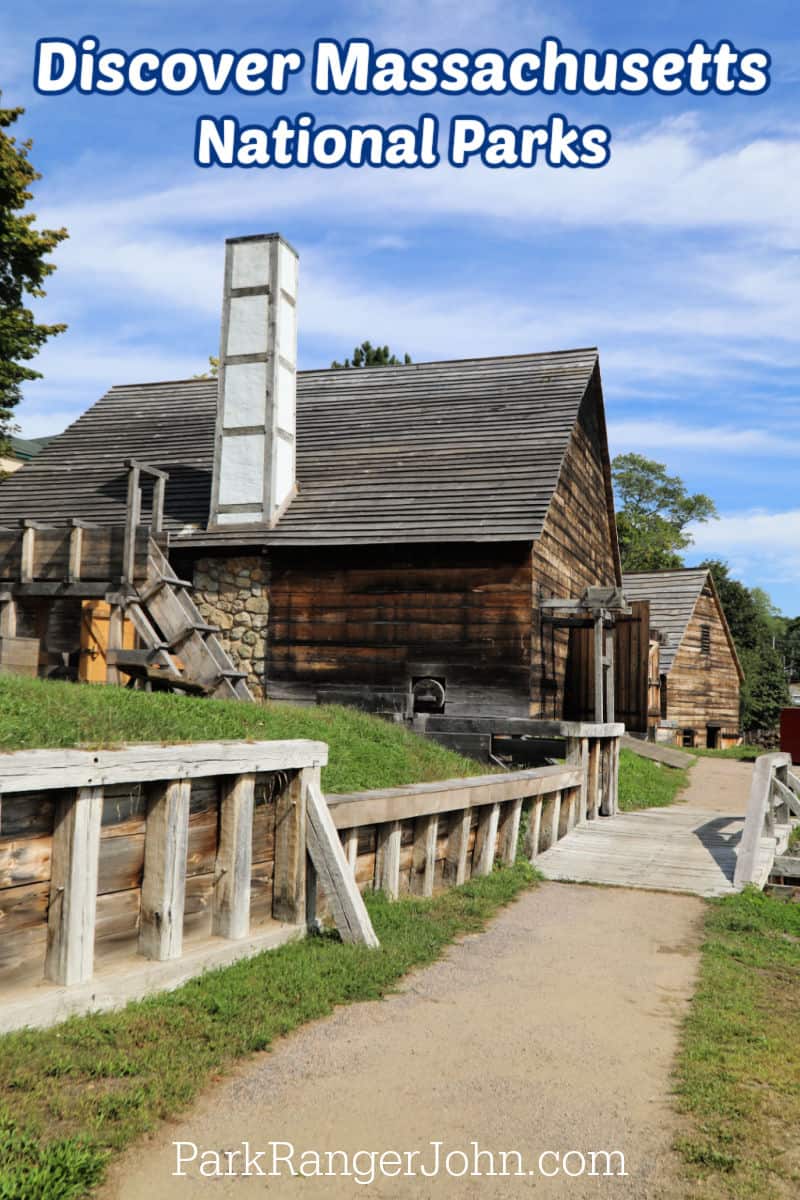
National Parks in Massachusetts
John Hancock (From Massachusetts) was the first founding father to sign the Declaration of Independence.
Presidents John Adams, John Quincy Adams, John F Kennedy, and George H.W. Bush were all born in Massachusetts.
The first Railroad and the first subway in the US was in Massachusetts.
I would venture to say that they are the land of firsts and there are many National Park Sites to support this. How many have you been to?
Adams National Historical Park
Top Things to do - Take a guided tour of the historic homes, Old House at Peace field, Tour John Adams and John Quincy Adams Birthplaces, View Enduring Legacy at the Adams National Historical Park Visitor Center, Wildlife Viewing
Lodging - There are no lodging facilities within the park. Lodging options near Adams National Historical Park include hotels in Quincy and Braintree. Additional choices can be found in downtown Boston and nearby Cambridge
Camping - There are no camping options within the park
Park Address - Visitor Center, 1250 Hancock Street, Quincy, MA 02169
Old House at Peace field, 135 Adams Street, Quincy, MA 02169
Adams NHP is located in Eastern Massachusetts approximately 7 miles southeast of Boston. The 11-acre park is open from spring through fall offering the opportunity to tour historic houses.
The park preserves the grounds, homes, and personal property of five generations of the Adams Family who lived here from 1720 to 1927. The Adams Family includes two Presidents, international diplomats, and notable historians/writers.
There are two houses located 75 feet apart that were the birthplaces of John Adams (2nd US President) and his son John Quincy Adams (6th US President). The Old House was built in 1731 and was home to John Adams, John Quincy Adams with Charles Francis Adams (Minister to Great Britain during the Civil War), Henry Adams, and Brooks Adams (both were literary historians).
The Old House Grounds include a historic orchard and formal gardens. The Stone Library from the 1870s houses more than 12,000 volumes.
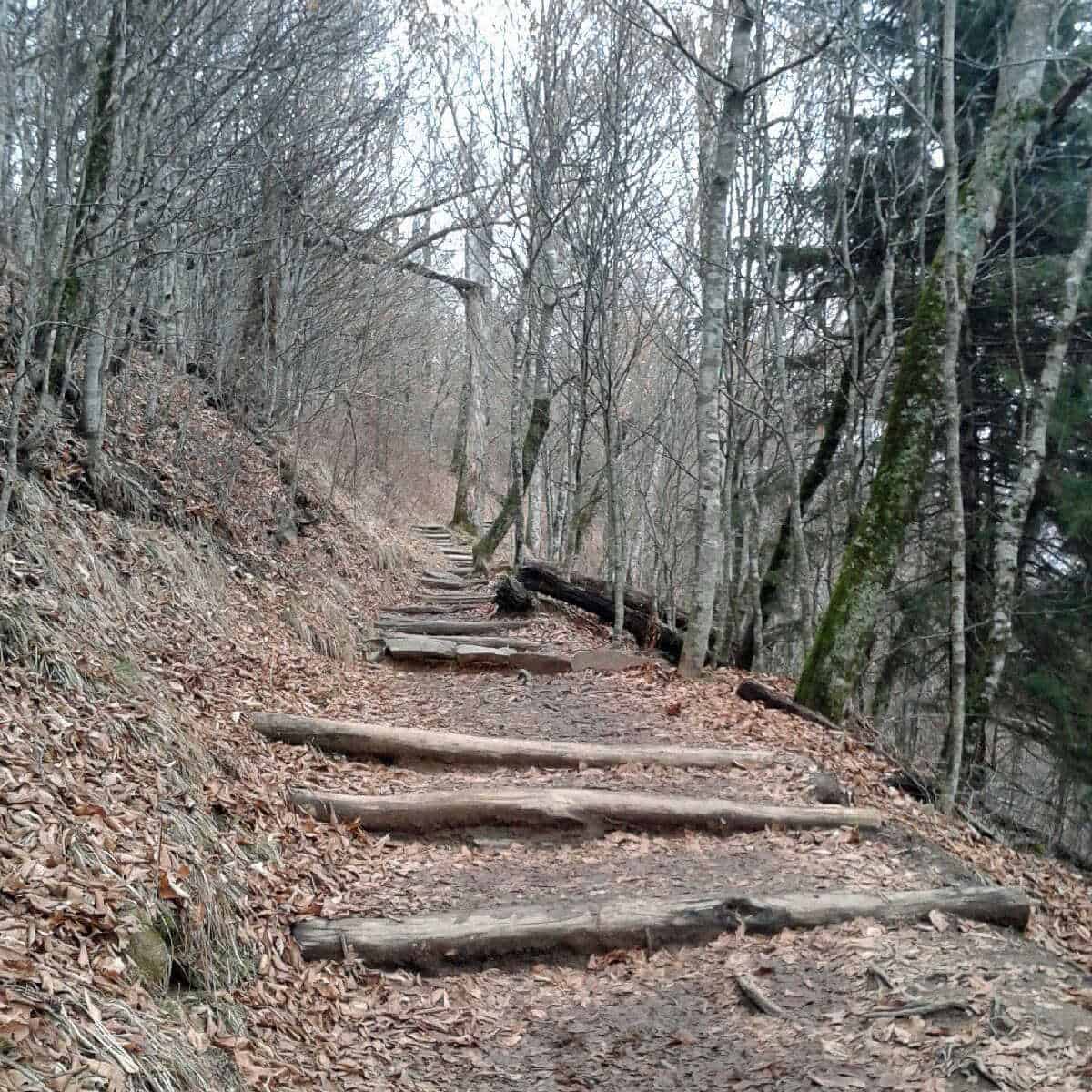
Appalachian National Scenic Trail (Georgia to Maine)
Top Things to do - Hiking, Backpacking, Birdwatching, Photography, Scenic Driving, Camping, Swimming, Stargazing, Picnicking
Lodging - Over 250 backcountry shelters can be found along the Appalachian Trail (A.T.) for backpackers, offered on a first-come, first-served basis. Additionally, lodging choices are accessible in or close to towns such as Blairsville (GA), Fontana Dam (NC), Damascus (VA), Boiling Springs (PA), Kent (CT), Gorham (NH), and more, offering a range of accommodations for hikers.
Camping - The Appalachian Trail, spanning from Georgia to Maine, offers numerous campsites. From Harpers Ferry, WV northward, hikers are required to use designated sites. In the Great Smoky Mountains National Park, camping is exclusively permitted at designated locations. Backcountry camping is possible at approximately 125 designated campsites and near most of the 260 shelters along the Trail. These sites may feature tent platforms, fire rings, and access to water sources, and availability operates on a first-come, first-served basis.
Park Address - 91 miles of the Appalachian Trail passes through the Berkshires. The A.T. passes through the highest point of the state at Mount Greylock with an elevation of 3491 feet.
Mount Greylock is said to have inspired Herman Melville to write Moby Dick.
For more information check out the Appalachian Trail Guide to Massachusetts.
Blackstone River Valley National Historical Park (RI, MA)
Top Things to do -Self-Guided Walking Tours, Biking at Blackstone River Bikeway, paddling down Blackstone Canal, Bird Watching, Become a Scout Ranger, Become a Junior Ranger, Be a B.A.R.K. Ranger (pets)
Lodging - The park does not offer lodging. Lodging options near the Massachusetts portion of Blackstone River Valley National Historical Park can be found in Worcester, Massachusetts, and nearby cities like Providence and Woonsocket, Rhode Island. Uxbridge, Massachusetts, and North Smithfield, Rhode Island, also offer accommodations.
Camping - There are no campgrounds within the park. Camping options near the Massachusetts portion of Blackstone River Valley National Historical Park can be found in state parks like Blackstone River State Park and Douglas State Forest, as well as in nearby private campgrounds.
Park Address - 67 Roosevelt Ave, Pawtucket, RI 02860
Blackstone River Valley NHP is located in Central Massachusetts and Northern Rhode Island. The park preserves 400,000 acres and is open year-round. You can enjoy hiking, biking, canoeing, kayaking, and touring historic and cultural sites.
The Blackstone River Valley has been called the birthplace of the American Industrial Revolution. This area is where English immigrant Samuel Slater took over a failed mill in Pawtucket, Rhode Island and made it the first successful water-powered cotton-spinning factory in the United States.
The success of this mill brought in more mills setting off a wave of industrialization and immigration that changed the face of the United States.
This is a park in progress that is still building out its programs. Currently, you can pick up a Blackstone Passport Book to find all the places to visit.
Boston African American National Historic Site
Top Things to do - Explore the rich history of the 19th-century Black community on Beacon Hill, Join a Park Ranger and hear stories about the activism and community of the Black neighborhood on Beacon Hill, Become a Junior Ranger, Watch a film
Lodging - Lodging options near the Boston African American National Historic Site in Beacon Hill include hotels, boutique inns, and bed and breakfasts. Additionally, downtown Boston and Back Bay offer a range of accommodations within easy reach of the site.
Camping - There are no camping opportunities within the park
Park Address - 46 Joy Street, Boston, MA 02114, USA
Boston African American NHS is located in Downtown Boston and includes less than 1 acre of land. The park is open year-round and offers tours of historic buildings.
The site includes the largest area of pre-Civil War African-American-owned structures in the United States. These sites include houses, businesses, schools, and churches that were part of a thriving community located on the north side of Beacon Hill.
Generations of African Americans struggled for equal rights locally and nationally. The Museum of African American History operates the Abiel Smith School which served as a segregated public school for black children from 1835 to 1855.
They also operate the African Meeting House which hosted speakers including Frederick Douglas and William Lloyd Garrison. Ranger programs are offered at the African Meeting House year-round.
Rangers are stationed at the Museum of African American History for historic talks and programs throughout operating hours. The Museum of African American History charges an admission fee but there is no fee to take a ranger-guided walking tour of the Black Heritage Trail®.
Boston Harbor Islands National Recreation Area
Top Things to do - walk a Civil War-era fort, visit historic lighthouses, explore tide pools, hike lush trails, camp under the stars, or relax while fishing, picnicking, or swimming
Lodging - Lodging is not available within the Boston Harbor Islands National Recreation Area. Visitors typically stay in hotels in Boston, Hull, or Quincy, using ferries to access the islands. Camping is an option on some islands, but reservations are required.
Camping - Camping near the Boston Harbor Islands National Recreation Area is available on some of the islands within the park, including Grape Island, Peddocks Island, Lovells Island, and Spectacle Island (yurt rentals). Reservations are necessary, and camping options are seasonal.
Park Address - 15 State Street, 4th Floor, Boston, MA 02109
Boston Harbor Islands NRA is located in Boston Harbor. The park is open year-round and offers hiking, camping, swimming, picnic spots, guided boat tours and the opportunity to visit historic structures.
This National Recreation Area was established in 1996 and compromises 34 separate sites along islands and mainland peninsulas. Spring through Fall offers the best opportunity to enjoy narrated cruises of historic Boston Harbor.
You can also tour the 19th-century Fort Warren on Georges Island which served as an active military port until 1947 and is now a National Historic Landmark.
Spectacle Island has the highest point within the park at 157 feet above Boston Harbor. There are 5 miles of hiking trails and epic views of the Boston skyline. Don't miss the visitor center with exhibits on the history of the island.
You can visit the country's oldest lighthouse on Little Brewster Island. Some of the islands are so small that they rarely visited. There are 30 sites within the park that can only be visited via boat. If you are driving you can check out Words End peninsula which offers hiking trails and beach areas.
Ferry boats leave from Boston Harbor, Hingham, Quincy, and Hull to visit many of the islands.
Have you visited any of the Hidden Boston sites?
Boston National Historical Park
Top Things to do - Start your visit at either the Faneuil Hall Visitor Center or the Charlestown Navy Yard Visitor Center, Visit Historic Sites and Museums, Self-Guided Tours, Join a Guided Tour or Program, Become a Junior Ranger or color Faneuil Hall, Become a Bark Ranger (pets)
Lodging - Lodging for the Boston National Historical Park can be found in various neighborhoods within Boston, such as Downtown, Charlestown, North End, Faneuil Hall/Quincy Market, Beacon Hill, Back Bay, and South Boston. You can also consider accommodations in nearby Cambridge.
Camping - There are no camping opportunities within Boston NHS
Park Address - The Boston National Historical Park is spread across multiple sites in Boston, Massachusetts, each with its own address.
Faneuil Hall Visitor Center - Address: 1 Faneuil Hall Square, Boston, MA 02109, USA
The Charlestown Navy Yard Visitor Center - Address: 1 1st Ave,Boston, MA, 02129
USS Constitution Museum - Address: Building 22, Charlestown Navy Yard, Boston, MA 02129, USA
Old North Church & Historic Site - Address: 193 Salem Street, Boston, MA 02113, USA
Bunker Hill Monument - Address: Monument Square, Charlestown, Boston, MA 02129, USA
Paul Revere House - Address: 19 North Square, Boston, MA 02113, USA
Dorchester Heights - Address: Thomas Park, South Boston, Boston, MA 02127, USA
Boston NHP is located in Downtown Boston and encompasses 43 acres. The park is open year-round and offers tours of historic sites.
Some of the most significant events in the American Revolutionary War and the push for independence happened near the city of Boston. Significant events include the Boston Tea Party, the midnight ride of Paul Revere, and the Battle of Bunker Hill.
You can now visit many of these important American Revolution sites within Boston National Historical Park. All of the sites minus Dorchester Heights are connected by the 2.5-mile Freedom Trail. This walking trail runs from Boston Common through the North End to Bunker Hill.
There is a redbrick path that guides you along the trail to make sure you do not miss any of the city's historic sites. Some of the sites along the trail are privately owned and may charge an admission fee.
The park has two visitor centers one is on the first floor of Faneuil Hall and the other in Boston Inner Harbor next to the historic U.S.S. Constitution. The visitor centers are a great place to pick up park maps, and junior ranger programs, and learn more about the park.
Cape Cod National Seashore
Top Things to do - Ranger-Guided Activities, Visit a Visitor Center, Hiking, Paddling, Biking, Bird Watching, Wildlife Viewing
Lodging - The National Park Service offers vacation house rentals within the Cape Cod National Seashore. These include the Bay View House, Beach View House, LeCount Beach House, Sunrise House, Ocean View House, Highland Beach Suites 1,2 and 3
Camping- Cape Cod National Seashore does not offer camping
Park Address - Headquarter Office: 50 Nauset Road, Eastham, MA 02642
Salt Pond Visitor Center, located at 50 Nauset Road, Eastham
The Province Lands Visitor Center is located at 171 Race Point Road
Cape Cod National Seashore is located in Eastern Massachusetts approximately 90 miles Southeast of Boston (55 miles via ferry). The park is open year-round but Spring through Fall offers the best opportunities to enjoy hiking, surfing, swimming, and exploring.
Cape Code NS protects 30 miles of beaches along with salt marshes, freshwater wetlands, and scattered woodlands. The Salt Pond Visitor Center is located at the corner of Nauset Road and US 6 in the village of Eastham.
The visitor center is the perfect place to pick up park maps, watch the park movie, and see the museum covering Cape Cod's cultural history.
Frederick Law Olmsted National Historic Site
Top Things to do -Take a ranger-guided tour, Explore the restored landscape, Experience special events, Become a Junior Ranger
Lodging - The Frederick Law Olmsted National Historic Site does not offer on-site lodging. You can find accommodations in nearby Brookline, Boston, Newton, Cambridge, and Jamaica Plain.
Camping - Camping is not available at the Frederick Law Olmsted National Historic Site
Park Address - 99 Warren Street, Brookline, MA 02445
Frederick Law Olmsted NHS is located in Eastern Massachusetts in Brookline a suburb of Boston. The park is open year-round and offers the opportunity to visit Olmsted's office and grounds.
Frederik Law Olmsted is considered the founder of American landscape architecture. Even though he lacked formal training he was partially or totally responsible for designing notable sites including Central Park (NYC), Prospect Park on the campus of Stanford University, the Biltmore Estate in North Carolina, the U.S. Capitol Grounds, and the National Zoo in Washington D.C.
He is also credited with working on the preservation of Yosemite Valley and Niagara Falls. Mr. Olmsted moved to Brookline in 1883 and founded one of the world's first offices dedicated to landscape design.
You can tour Olmsted's house called Fairsted, his office, and the grounds. You can also view design documents and historical materials related to the more than 5,000 landscape design projects his office worked on.
John F. Kennedy National Historic Site
Top Things to do - Tour the Kennedy Birthplace, Ranger Led Tours, Junior Ranger Program, Self-Guided Tours
Lodging - The John F. Kennedy National Historic Site does not offer lodging within the park. Visitors typically find lodging options in Brookline or nearby areas in the greater Boston area.
Camping - There is no camping available within the park.
Park Address - 83 Beals Street, Brookline, MA 02446
John F. Kennedy NHS is also located in Brookline a western suburb of Boston. The park offers tours of the birthplace of JFK the 35th President of the United States.
Four years after the assassination of JFK his mother Rose Kennedy restored the house to reflect her memory of its appearance. The Kennedy Family donated the house to the National Park Service after its restoration.
You can take a ranger-guided tour of the household to see furniture, photos, and mementos including the bed in which JFK was born, his bassinet, and the piano which he took lessons as a kid.
Longfellow House-Washington’s Headquarters National Historic Site
Top Things to do -Visit the Historic House, Join Community Events, Spend the day picnicking at the Garden and Grounds
Lodging - The Longfellow House-Washington's Headquarters National Historic Site does not offer on-site lodging. Visitors can find lodging options in Cambridge, Boston, Brookline, and Somerville, and consider vacation rentals in the area.
Camping - There are no campgrounds within the National Historic Site
Park Address - 105 Brattle Street, Cambridge 02138
Longfellow House - Washington's Headquarters NHS is located in Cambridge just west of Boston. The site gives you the opportunity to view the gardens and tour the historic house.
Henry Wadsworth Longfellow was born in 1807 and wrote poems such a "The Song of Hiawatha", "Paul Revere's Ride", and "The Courtship of Miles Standish". In 1843 Fanny Appleton's father purchased the house as a wedding gift when she married Longfellow.
Longfellow is one of the best-known literary figures in the United States. Guests to the house included Nathaniel Hawthorne, Ralph Waldo Emerson, Charles Dickens, and Oscar Wilde.
The house had already gained fame even before Longfellow moved in. George Washington assumed command of the Continental Army on July 3, 1775, and the house served as his headquarters for nine months.
Lowell National Historic Park
Top Things to do - Begin your visit at the National Park Visitor, Boott Cotton Mills Museum, You can visit the boarding houses where the mill girls stayed and enjoy a ride on the canal boat, Special Events and Programs
Lodging - While there are no accommodations directly within the park, you can find various hotels, inns, and accommodations in Lowell and nearby areas.
Camping - There are no camping opportunities within the park
Park Address - 246 Market Street, Lowell, MA 01852
Lowell, Massachusetts is about 25 miles north of Boston, and just south of New Hampshire. Lowell National Historical Park commemorates the story of the Industrial Revolution in America.
Lowell was developed in the early 19th century as a planned industrial city focusing on textile manufacturing.
At the Boott Cotton Mills Museum, you can experience the extreme noise of power looms from the 1920s operating in a weaving room (they hand out earplugs before you go into the room.) Take a trolley or a canal ride. The Lowell National Historical Park features exhibits at the Visitor Center, the Mill Girls & Immigrants Exhibit, and the Center for Lowell History. The offerings of the park are either free or inexpensive.
There are many other attractions to visit while you're in Lowell. Interested in fiber arts? Check out the American Textile History Museum and the New England Quilt Museum. Art lovers can enjoy the Brush with History Art Gallery and Studios and the Whistler House and Museum.
Transportation buffs will be interested in the Boston & Maine Railroad Historical Society, and the National Streetcar Museum at Lowell.
Minute Man National Historical Park
Top Things to do - Experience the park through Guided Programs, Hike the Battle Road Trail, visit Hartwell Tavern, join Special Events, Be a Junior Ranger, watch "The Road To Revolution" (multimedia presentation), Bird Watching
Lodging - There are no lodging facilities within Minute Man National Historical Park. Lodging options can be found in nearby towns like Concord, Lexington, and Lincoln. These towns offer hotels, inns, bed and breakfasts, and vacation rentals. Reservations are recommended, especially during peak seasons.
Camping - There are no campgrounds within the park
Park Address - Minute Man Visitor Center, 250 North Great Road, Lincoln, MA 01773
Minute Man NHP is located 15 miles northwest of Boston. The park offers the opportunity to view historic sites.
On April 19, 1775, American patriot militiamen were ordered to fire back at British Soldiers for the first time. This park preserves sites along the Battle Road. The route was followed by British troops marching from Boston to seize and destroy ammunition stored by the colonial militia in the town of Concord.
The Visitor Center is the perfect place to start your visit. You can learn more about Paul Revere's Ride along with the battle of Lexington Green at North Bridge.
New Bedford Whaling National Historical Park
Top Things to do - visit the Visitor Center, Historic District Walking Tour, the New Bedford Whaling Museum, The Corson MakerSpace
Lodging - There are no lodging facilities within the park
Camping - No camping opportunities are available
Park Address - 33 William Street, New Bedford 02740
New Bedford Whaling NHP is located in Southeastern Massachusetts approximately 40 miles from Providence, Rhode Island. The park offers the opportunity to explore the 19th-century whaling capital of the world.
During the 19th century whale oil was a lucrative business. It was used in lamps to light homes and businesses around the world. New Bedford, Massachusetts was the world's largest whaling capital. In 1850 more whaling voyages left from New Bedford than the rest of the world combined.
The park preserves and interprets the story of 19th-century whaling. One of the sailors who left New Bedford was Herman Melville who wrote Moby Dick.
The National Park Service has a partnership with multiple organizations to help tell the story of whaling in New Bedford. The park visitor center is located in an 1853 Greek Revival building that was formerly a bank and courthouse.
The park is one of the top things to do in New Bedford, MA!
New England National Scenic Trail (MA, CT)
The New England National Scenic Trail was established as one of the newest National Park Service trails on November 16, 2023.
The New England Trail covers 235 miles from Long Island Sound across the mountain summits in Connecticut and Massachusetts.
Salem Maritime National Historic Site
Top Things to do - Discover historic sites and structures at Salem Maritime, view exhibits at the Salem Armory Visitor Center, Get your passport stamped and explore the unique Waite & Peirce Park Store, Become a Junior Park Ranger, your pets can become a Salem Maritime B.A.R.K. Ranger, see the Central Wharf Restrooms, Narbonne House, Public Stores and Scale House, Derby Wharf and Park Grounds Around Historic Structures
Lodging - Salem Maritime National Historic Site does not offer on-site lodging. Visitors can find various lodging options in Salem's downtown area, including hotels, bed and breakfasts, inns, and vacation rentals.
Camping - There are no campgrounds within the park
Park Address - Salem Armory Visitor Center, 2 New Liberty Street, Salem, MA 01970
Salem Maritime NHS is located 15 miles northeast of Boston. The park offers the opportunity to view a reproduction sailing ship and multiple historic buildings.
During the decades following the United States independence from Britain, the town of Salem became one of the nation's most important ports. The park became the first National Historic Site in the country when it was dedicated in 1938.
The park encompasses historic buildings, wharves, and a reproduction tall ship. You can also see the Narbonne House which was built in 1675 for butcher Thomas Ives. The Derby House was built in 1762 as a wedding gift for Elias Hasket Derby and his wife Elizabeth.
The 1819 Custom House where famed author Nathanial Hawthorne worked from 1846 to 1848. The West India Goods Store which was built in 1804 was used as a warehouse and store for items from all over the world.
The visitor center is located in a former warehouse built in the 1770s. You can pick up park maps, sign up for tours of the Friendship reproduction tall ship, and learn more about the park.
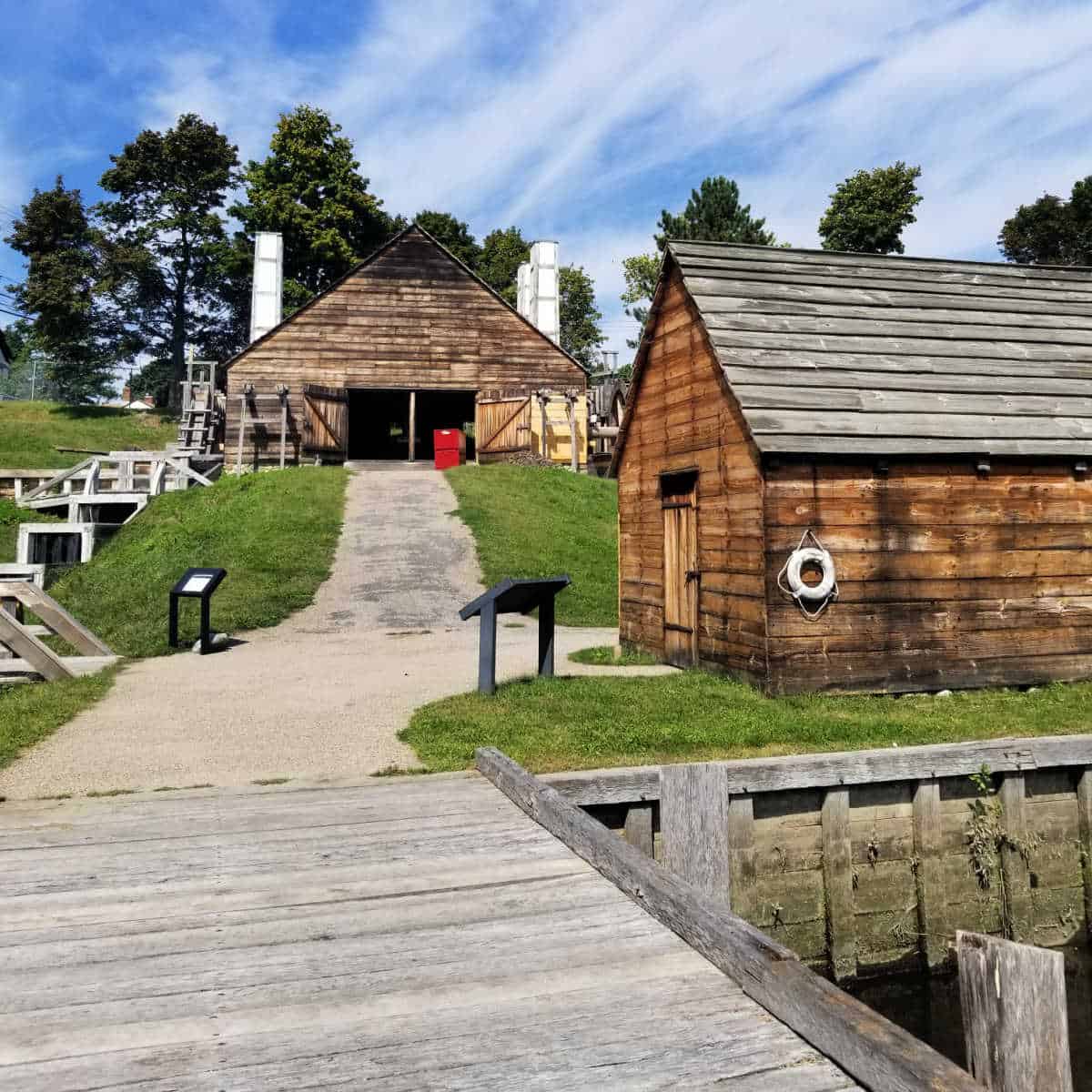
Saugus Iron Works National Historic Site
Top Things to do - Self-Guided Tours, Visit the reconstructed blast furnace, the centerpiece of the site, and see demonstrations of iron-making techniques, Become a Junior Park Ranger, Explore the Iron Work House, visit the Saugus Iron Works Museum, Industrial Site Buildings, walk the Park Grounds and Nature Trail
Lodging - Saugus Iron Works National Historic Site does not offer on-site lodging options within the park itself. Visitors seeking lodging will find various hotels, motels, inns, and other accommodations in nearby towns and cities, including Saugus, Lynn, and the greater Boston area.
Camping - There are no camping options within the park
Park Address -244 Central St, Saugus, MA 01906
Saugus Iron Works NHS is located 9 miles northeast of Boston. You can experience reconstructed ironworks and learn about the Saugus Iron Works from 1646 to 1668.
The National Park Service also supports the Saugus Iron Works. "Explore this place where European iron makers brought their special skills to a young Massachusetts colony. Three-hundred-year-old artifacts, working waterwheels, and mill machinery help to tell the story of a business failure destined to be a National Park."
There are pictures of the original structures on the site which were uncovered during archaeological digs. These include the blast furnace, forge, and slitting mill.
The first integrated ironworks in the US was built at this site in the mid-17th century. Visitors will see a reconstructed ironworks settlement and an open-air museum with working waterwheels. You will want to start your visit with a 12-minute video "Iron Works on the Saugus" which does a great job explaining the importance of this site.
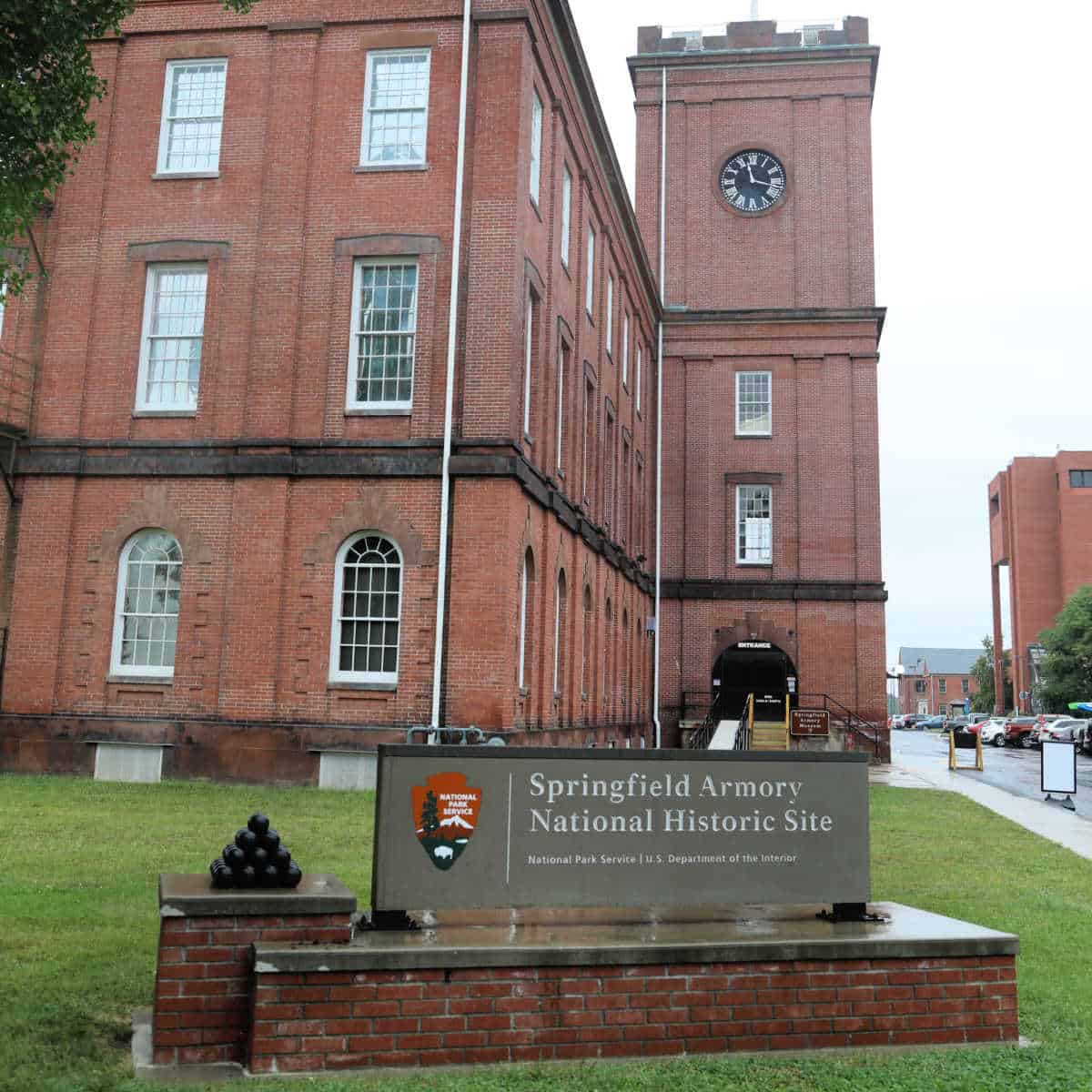
Springfield Armory National Historic Site
Top Things to do -Visit the Springfield Armory Museum, Walk around the Armory Grounds, Take a Stroll Behind Quarters 1, Picnic on the Armory Grounds, Join Junior Ranger Activities
Lodging - There are no lodging facilities within the park
Camping - No camping at Springfield Armory National Historic Site
Park Address - 1 Armory Square, Springfield, MA. 01105
Springfield Armory NHS is located in Southwestern Massachusetts in the city of Springfield. The park offers the chance to learn about the manufacturing of flintlock muskets.
After the United States won its independence, President George Washington ordered the Springfield Armory to be used to manufacture flintlock muskets so the US would not be dependent on foreign weapons.
Springfield Armory was in production for 174 years until 1968. The armory developed and manufactured America's military weapons including the muzzle-loading Springfield rifle of the Civil War, the bolt-action Springfield Model 1903 from World War I, Springfield M-1 Garand Rifle from World War II.
Don't miss the park film which does a great job of explaining the armory history. The site takes at least an hour or more to explore. The organ of guns is one of the highlights of the park.
List of National Parks in Massachusetts
- Adams National Historical Park
- Appalachian National Scenic Trail (Georgia to Maine)
- Blackstone River Valley National Historical Park (RI, MA)
- Boston African American National Historic Site
- Boston Harbor Islands National Recreation Area
- Boston National Historical Park
- Cape Cod National Seashore
- Frederick Law Olmsted National Historic Site
- John F. Kennedy National Historic Site
- Longfellow House-Washington’s Headquarters National Historic Site
- Lowell National Historical Park
- Minute Man National Historical Park
- New Bedford Whaling National Historical Park
- New England National Scenic Trail (MA, CT)
- Salem Maritime National Historic Site
- Saugus Iron Works National Historic Site
- Springfield Armory National Historic Site
Affiliated Sites
- Essex National Heritage Area
- John H. Chafee Blackstone River Valley National Heritage Corridor (MA, RI)
- The Last Green Valley National Heritage Corridor (CT, MA)
- Washington – Rochambeau National Historic Trail (MA, RI, CT, NY, NJ, PA, DE, MD, VA, DC)
There are 15 Massachusetts National Parks with over 10 million visitors a year. These visitors create over $521 million in economic benefits!
National Parks in Massachusetts include 5 National Heritage Areas, 3 Wild and Scenic Rivers managed by the park service along with 3 National Trails managed by the park service.
There are 4,312 National Register of Historic Places listings in Massachusetts along with 189 National Historic Landmarks.
11 National Natural Landmarks along with 1,706 places recorded by the Heritage Documentation Program and over 5.3 million objects in the Massachusetts National Park museum collection.
For an entire list of US National Parks head over to our list of US National Parks in Alphabetical Order. We also have a printable checklist of all 417 National Park properties in the United States available.
If you have dreamed of working in the National Parks make sure and check out our article on How to Become a Park Ranger. Working in the parks is one of the most amazing jobs you can find. There is just something special about waking up and knowing you are going to work in a beautiful park.
Additional National Park Travel Resources
Learn more about National Park Passes for parks that have an entrance fee.
$80.00 - For the America the Beautiful/National Park Pass. The pass covers entrance fees to all US National Park Sites and over 2,000 Federal Recreation Fee Sites for an entire year and covers everyone in the car for per-vehicle sites and up to 4 adults for per-person sites.
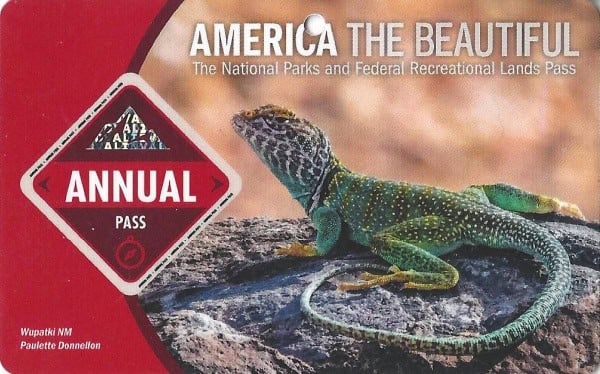
Buy your pass at this link, and REI will donate 10% of pass proceeds to the National Forest Foundation, National Park Foundation, and the U.S. Endowment for Forestry & Communities.
National Park Free Entrance Days -Mark your calendars with the five free entrance days the National Park Service offers annually.
Free Entrance Days -Mark your calendars with the five free entrance days the National Park Service offers annually.
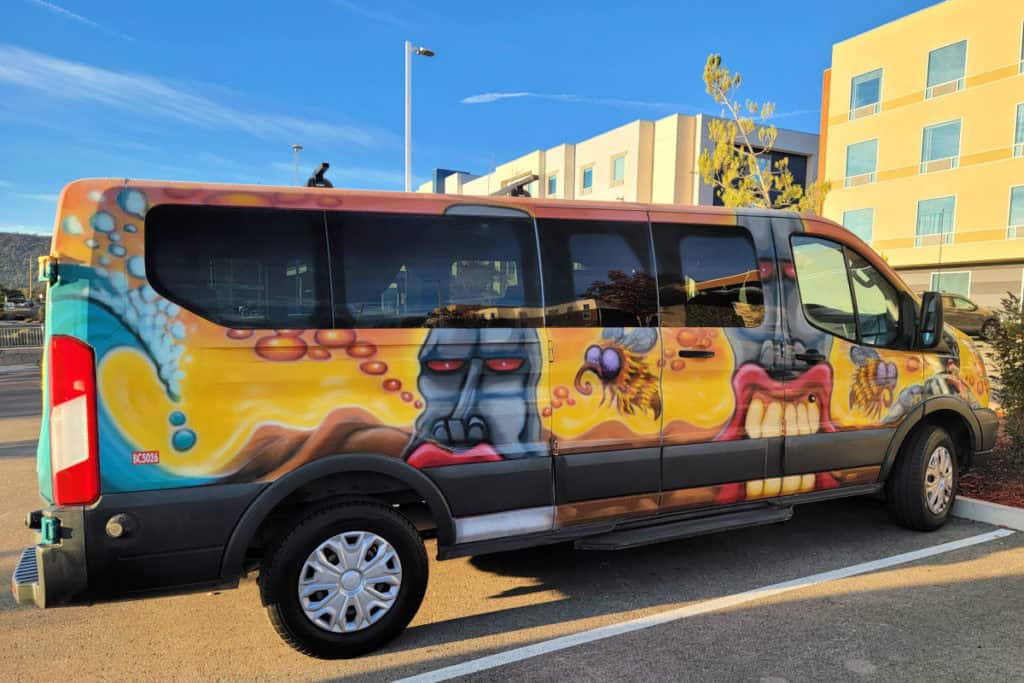
For a fun adventure check out Escape Campervans. These campervans have built in beds, kitchen area with refrigerators, and more. You can have them fully set up with kitchen supplies, bedding, and other fun extras. They are painted with epic designs you can't miss!
Escape Campervans has offices in Vancouver, Seattle, Portland, San Francisco, Las Vegas, Los Angeles, Phoenix, Salt Lake City, Denver, New York, and Orlando
National Parks in neighboring states
National Parks in Rhode Island
National Parks in New Hampshire
Make sure to follow Park Ranger John on Facebook, Instagram, Pinterest, and TikTok
